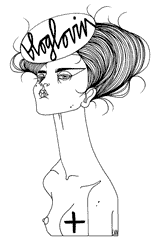One summer night on the year I graduated from college, on a beach miles away from home, I slept on the sand under the stars, Snow Patrol’s “Chasing Cars” on my iPod, next to friends who were, as I was, leaving school behind in order to marshal in the rest of our lives.
A year later, still miles away from home, I sat atop a cliff under the scorching afternoon sun, helmet and gloves on, waiting for my turn to rappel down a waterfall, on a trip with newfound friends, a band of yuppies looking for an adventure and an escape (albeit temporarily) from office cubicles.
Only a few months back, still far away from home (as I always seem to be), I swam through a hole beneath a massive limestone precipice and found myself in a deep aquamarine lake enclosed by towering cliffs, as I floated effortlessly in its still, buoyant waters.
There are memories on a trip that just can’t be captured in pictures or on film. Such moments don’t just include a picturesque landscape, a daredevil activity or a funny tourist pose. Instead, they’re often a simple, otherwise commonplace moment on the trip, but for one reason or another, bring about a bevy of emotion – for me it is often the “I wouldn’t want to be anywhere else” feeling, a feeling of genuine fulfillment born from a freedom from the worries and pressures of a life temporarily left behind at home for the discovery of a place unknown.
On our third day in Cambodia, we were up and about bright and early yet again, ready for another day of exploring centuries-old temples. We rode on Mr. Ou Houk’s tuktuk along Angkor Wat’s massive moat, its still waters reflecting the many trees that surrounded it. Eventually we turned into a road densely lined with trees on either side, which allowed streaks of the early morning sunshine to pass through them. There was a beautiful and subtle orange tint to our surroundings; the weather was cool and the sunlight warm on our skin. The sound of the tuktuk, much like that of a tricycle’s, would’ve been annoying except it wasn’t – perhaps it was the quiet calm of the surroundings that drowned the tuktuk noise away. Or maybe it was my iPod. Yes, I was listening to Snow Patrol that morning.
We passed by a centuries-old man-made lake, and through rice fields dotted with small houses. I’m very familiar with what provincial life is like in the Philippines, having grown up in the province, but Cambodia’s countryside was different – it was a lot more peaceful and quiet, a lot more backward, for lack of a better term, but not in a bad way. Cambodia’s countryside just felt more isolated from the developments and technologies of the modern world, which made it even more beautiful. As we rode on our tuktuk, exposed to the elements and with a constant breeze against our faces, it was evident that in this spot in the world, even the air seemed purer, and we relished every lungful we breathed in which we knew was free of smog and pollution.
And that, is my favorite un-captured memory of our Cambodia-Vietnam trip.
Our first temple of the day was Banteay Srey with its beautiful and delicate carvings. And since I’ve rambled on long enough at the beginning of this post, I’ll let the pictures do the talking for this one:




After Banteay Srey, we stopped roadside to check out some stores that sold a gamut of local items – from sugar candies to woven baskets and what we fondly called “sumo” pants. It was also a chance to get to know the locals.




On this second day of our exploration of the Angkor temples, we spent quite a lot of time on the road from one temple to another, riding on Mr. Ou Houk’s tuktuk across the Cambodian countryside. We therefore spent the time getting to know Sokha, our tour guide. Although seemingly reserved and very serious at first, we found that Sokha was actually very open and generous when it came to sharing his life stories. We got a first-hand account of Cambodia’s recent brutal history, a recent past that still scarred Cambodia’s present, at least from the brief conversations we had with various locals, Sokha included.
We brushed on politics, and Sokha, who formerly served for the Cambodian army, enlightened us with his thoughts on the matter – while there was much that could still be done to improve his country’s government (which ranks as one of the most corrupt in the world, apparently), there is finally peace in Cambodia and for now, perhaps that is enough.

As with most conversations led by three girls, our questions eventually turned to Sokha’s love life, and I felt he had a simple but noteworthy take on the matter: don’t go marrying anyone for the wrong reasons, even if tradition would dictate that you belonged together. Marriage doesn’t always have to be the immediate answer to happiness – as long as you’re content, with a stable job and land to live on, you can live your life unhurriedly and wait for the right person to come your way.
Our second temple of the day is not a popular one but a personal favorite. Banteay Samre was perhaps the most hidden among all the temples we visited on our two-day trip, its location off the standard tourist route in the archaeological park. It had a grand ancient walkway that today leads to the forest, but in the past was perhaps the main route from the city to the temple.



The inside of the temple looked quite like an English courtyard, with its grassy lawn and the solitary tree that grew by the inner temple. We spent quite a while just sitting by the pillars that lined its inner walls, enjoying the serenity of the place, as unlike the previous temples we had visited, we virtually had Banteay Samre all to ourselves.
 Above Photo by Tiff Orbien
Above Photo by Tiff Orbien



Within the inner temple, Banteay Samre was even more beautiful, as it was covered in intricate carvings much like the grand temples of Bayon and Angkor Wat, but in a much grounded, much smaller scale that perhaps gave it a more intimate, more soulful feel. Upon leaving Banteay Samre, Tiff, Jen and I agreed that it was probably the most special of the temples we visited, and therefore called it our “happy place” (cheesy, I know, but it made sense at the time!).



After Banteay Samre, we had lunch at a restaurant in front of the man-made lake we passed earlier in the day. It wasn’t long before we headed out for our last temple – and boy, was it a grand one!
 Above Photo by Tiff Orbien
Above Photo by Tiff Orbien
Pre Rup is a massive temple mountain that predates Angkor Wat. Unlike Angkor Wat or Banteay Samre that slowly unravels itself to a traveler, Pre Rup is located on a street corner (albeit a street corner in the middle of the forest) and comes into view quite quickly, and because it’s so massive, it’s hard not to notice it. It’s so huge that on its top steps, the view across the Siem Reap forest is a spectacular one.

One cool thing I noticed about the temples within the Angkor Archaeological Park is that they’re so accessible to its guests. Except for Ta Prohm which had some areas cordoned off, we were free to wander anywhere within – and on top – of the Angkor temples. This meant that anyone could climb up the steep and narrow steps leading to the dizzying heights of Pre Rup, which offered a rather nerve-wracking climb that was rewarded by an amazing view of the forest of Siem Reap.

Being on top of Pre Rup with its spectacular view of the horizon begged for a moment of contemplation, and so the three of us wandered the top level of the temple separately, perhaps looking back and slowly starting to digest what we had seen and experienced in the past two days. I felt an immense sense of gratitude on my part – to have witnessed that much history, to have seen and touched and stood upon something that had been there for centuries, which someone in another time – another world, even – also witnessed and saw, touched and stood upon…well, I felt pretty damn lucky. This will sound strange, weird, cheesy or incredibly nerdy, depending on who’s reading it, but to be honest, being there, on top of an amazing centuries-old structure by an ancient civilization, I couldn’t help but feel a connection to an era that had long gone and that was not my own, and I really, truly felt the immensity and expanse of time. The first time I ever rode a plane, I looked out and saw a wide expanse of land and sea, and I couldn’t help but feel incredibly small. On top of Pre Rup in the forest of Siem Reap, I had a similar feeling, only it made me realize that I wasn’t just a speck in the world we live in now, but that I was also even more of a speck in the history of time.


But as profound moments are always fleeting, we had to descend from the enlightening heights of Pre Rup and were brought back to the real world as soon as we left the Angkor Archaeological Park. In the city proper of Siem Reap, we window-shopped for souvenirs and bought processed food at a huge convenience store. We then checked out a shop that sold accessories made out of crocodile skin – and let me tell you, bags with crocodile eyes on them are not a pretty sight. Tiff headed to the post office because she was contemplating buying a 50’s inspired bike to send home, while Jen and I wandered into the central market and bought random souvenirs. That’s the thing about travelling these days – even if you say you’re not a tourist, and that you’re a genuine, hardcore traveler, it’s hard not to give in to the temptation of retail therapy, or a nice clean bathroom, and the many other modern-world things that continue to spoil city folk like us. Yet you’ll always have memories of your profound, un-captured and enlightening moments, and that perhaps is good enough.

































































